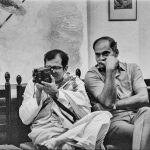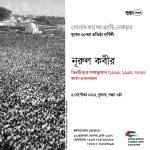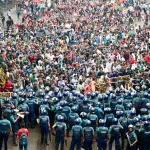by rahnuma ahmed
Romel Chakma, 20 year-old HSC examinee and student leader of Pahari Chatra Parishad,
was picked up by army personnel on April 5, 2017. Allegedly tortured, he died in hospital two weeks later.

How does one restore dignity to the memory of a youth who was picked up and tortured, who died of torture, whose body was not handed over to family members for cremation, but burnt after pouring petrol and kerosene?
These acts?as already reported and commented upon in the national media, and confirmed by interviews conducted by me in Rangamati and Chittagong?were allegedly committed by army personnel. Not off-duty, out on a rampage (as if that could be excused), but officially, in the pursuit of their duties. Personnel, reportedly belonging to the 305thInfantry Brigade, stationed in Naniachar Zone.
Stray thoughts wander in my head. I am reminded of American soldiers in Afghanistan and Iraq, of huge billboards in Sajek, Baghaichari Zone (Rangamati), and of Holey Artisan?s attackers.
US soldiers had desecrated the bodies of Taliban fighters in Afghanistan, they had burnt them, and used the charred and smoking remains to taunt other militants nearby. US Marines in Iraq had behaved similarly, they had doused the bodies of insurgents with gasoline and set them on fire. When American soldiers behave thus, we recognise these for what they are, the acts of invaders, aggressors, colonial occupiers. The theory of ?a few bad apples?, regurgitated endlessly in the Western media, invisibilises the conditions of their creation and sustenance.
The Marine Corps launched a criminal investigation in Afghanistan. The accused defended themselves by citing ?hygiene reasons.? The investigation (predictably enough?) found no evidence of ?desecration? or ?violation of the Law of War? (according to the Geneva Conventions, soldiers are required to ensure that the ?dead are honourably interred, if possible according to the rites of the religion to which they belonged?). The report concluded that the actions of the soldiers were caused by, among other things, a ?lack of knowledge and respect for local Afghan customs and tradition.?
If only the soldiers had known that Muslim bodies should be washed, wrapped in white cloth, and buried at the earliest?these gruesome acts wouldn?t have happened, is what the US war machine?s spinmasters want us to believe.
?Demonstrate proper respect toward the culture and tradition of the local people?? huge billboards advise Bengali tourists and travellers on the road to Sajek, a lush green valley surrounded by misty mountains, billed as the ?paradise of Bangladesh.? Not known to many, the invocation was added after the earlier one??Carry chocolates for the local children which will make them happy??led to a Jumma child being crushed under the wheels of a vehicle, as she ran to pick up the sweets cheerily tossed out by departing tourists in early 2016.
Lavish words of praise for the army are noticeable on the Internet for having ?opened up? Sajek for Bengali tourists, for having made it ?secure.? The tip for ?carrying chocolates? is still up on the Region Officers? Club Khagrachari (ROCK) website (rock-sajek.com/Attention).
The bodies of the Holey Artisan attackers were buried in the Jurain graveyard in accordance with ?religious rites? by Anjuman Mufidul Islam, a Muslim charity organisation. ?We gave the six bodies to Dhaka Metropolitan Police. Since their death no one came to us to take their bodies,? said Inter Services Public Relations (ISPR) Director Colonel Rashidul Hasan. The bodies of the five attackers and the pizza chef, suspected of being a supporter, had been preserved in the Combined Military Hospital (CMH) mortuary for over eighty days.
Despite the five having shot and hacked to death twenty-three people, including seventeen foreigners, their bodies had not been burned with petrol and kerosene. Institutional codes of conduct, and respect toward the ?culture and tradition of the locals? had prevailed. As they should.
The Chief of Army Staff General Abu Shafiul Huq was recently in Nigeria to strengthen the relationship between the two armies. During his visit, he delivered a lecture on ?Counter-Insurgency Operations: Bangladesh Perspective?, at the National Defence College, Abuja.
According to reports published in the English-language press of Nigeria, General Huq said, the basic policy for fighting insurgency consists in identifying the ?perceived right cause.? Deprivation, which may be either socio-economic or political, should be addressed; development projects should be initiated to retrieve faith in the government. The counterinsurgency campaign must reach out to all institutions, including religious ones. Media-military partnerships are very important since it is through the media that the military makes its operations transparent and accountable to the public (Daily Trust, April 25, 2017).
The Chief of Army Staff also said, the Bangladesh army had fought a very long insurgency war, its success was due to the idea that insurgency cannot be fought by the military alone. It must be a ?total approach??political, ideological, economic, and military. ?The military is [only] one component in fighting the insurgency.?
In his welcome address, the Nigerian Chief of Army Staff Lieutenant General Tukur Buratai, spoke appreciatively of the ?knowledge acquired from the Bangladesh experience in counter-insurgency? and also, of his military training at the National Defence College (NDC), Bangladesh, in 2008. Collaboration with the Bangladesh army had been very fruitful, the Nigerian army had achieved ?tremendous progress? in its fight against the Boko-Haram insurgency (Greenbarge Reporters, April 22, 2017).
Yes, it?s true. The Jummas?the collective name for eleven multilingual indigenous peoples? groups, residents of the three districts of the Chittagong Hill Tracts (CHT), Bawm, Chakma, Chak, Khyang, Khumi, Lushai, Marma, Pankhu, Mro, Taungchangya and Tripura, who appropriated a derogatory word, ?jhum chaash? (?slash and burn cultivation?), and imbued it with new meanings of honor and solidarity?do, have a strong sense of deprivation.
The construction of the hydro-electric power plant at Kaptai, for one, an initiative which was part of military ruler President Mohammad Ayub Khan?s ?Decade of Development? (1958-1968). As a result, 54,000 acres of cultivable land (40% of CHT?s land mass) was submerged, including ?old? Rangamati town, the Chakma Raja?s palace, and the homes of 18,000 families; 100,000 indigenous people were made homeless, 70% of them Chakmas. Many of those displaced were forced to move again when the resettlement camps were flooded, apparently, the American engineers had underestimated the size of the reservoir. Nearly fifty thousand of those displaced migrated to India as refugees, many of them still remain stateless, unrecognised as (environmental) refugees by the UNHCR.
For the Jummas, it was the Great Exodus (Bara Parang). They had not been consulted, no provision had been made for adequate relocation, it ?turned us into paupers? (Shilabrata Tangchangya). The construction of the dam provided work to thousands of Bengalis, little electricity to East Pakistan (0.5% of its total energy needs), and none to the CHT. Bengalis speak of the Kaptai Lake as a ?beauty spot?; the Jummas, as their ?teardrop.? Hydroelectric dams are now acknowledged to be environmental disasters (wildlife impact, global warming emission), but there is no thought of decommissioning the Kaptai dam, of maybe, turning the old powerhouse into a museum, the Bara Parang Memorial, to serve as a reminder of the nightmare inflicted on indigenous people by a military ruler, pursuing anti-people dreams of development.
And second, the issue of national identity. In mid-February 1972, Manabendra Narayan Larma, the only independent candidate to have won a parliamentary seat in the 1970 elections, led a delegation to Sheikh Mujibur Rahman, by then, the prime minister of newly-independent Bangladesh. Larma tabled the demand for CHT autonomy. Interpreted as a demand for secession, Sheikh Mujib advised Larma and the others to ?become Bengalis? (?tora shob bangali hoiya ja?). Larma formed the Parbatya Chattagram Jana Samhati Samity (PCJSS) on March 7, 1972.
The Constitution was adopted on November 4, 1972. Bangladesh was declared to be a ?unitary state,? its state language was ?Bengali,? its citizens were to be known as ?Bengali? (Articles 1, 3 and 6); all other ethno-linguistic people were airbrushed out of the nation?s imaginary. Larma refused to endorse the constitution for it had failed to, ?recognise the existence of other national communities in Bangladesh. ? It makes no mention about the CHT?. [T]he framers of the Constitution have forgotten my land, my people? You cannot impose your national identity on others. I am a Chakma not a Bengali? They [hill people] can never become Bengali.? The military wing (Shanti Bahini) of the PCJSS was formed on January 7, 1973.
The Fifteenth Amendment to the constitution, passed by parliament on June 30, 2011, while declaring that the citizens of Bangladesh are ?Bangladeshis? (drawing on the constitutional amendment introduced by the military ruler Ziaur Rahman, 1976-1981) has brought back the idea of Bengali national identity?with a vengeance. If one does not agree that the ?Bangalees [are] a nation? (Article 6 (2)), one could be accused of sedition (Article 7). If found guilty, hanged.
New Age had asked writers, lawmakers, teachers and cultural activists what they thought of the Fifteenth Amendment (June 12, 2012). While the Awami League MP from Khagrachari Jatindra Lal Tripura, had insisted that one should look at the ?bright side of things,? i.e., the inclusion of Article 23A, which protects the culture and tradition of ?tribes, minor races, ethnic sects and communities,? the president of Jatiya Samajtantrik Dal and MP Hasanul Haque Inu (currently, information minister), had courageously said, Article 6 contains ?totally contradictory? statements?it says, ?all citizens shall be known as Bangladeshis? and that the people shall be known as ?Bengalis.? The article needs to be ?amended.?
The insurgency finally came to an end after nearly twentyfive years. The Shanti Bahini laid down their arms, and the PCJSS signed the CHT Accord (commonly known as the Peace Accord) with representatives of Sheikh Hasina-led Awami League government (1996-2001) on December 2, 1997.
Has the CHT Accord ushered in peace? No.
The prime minister claims that ?most of the articles? of the Accord have been implemented?48 out of 72 completely, 15 partially, 9 are being processed. The Jummas don?t agree. The leader of the PCJSS, Jyotirindra Bodhipriya (Santu) Larma accuses the government of having tricked and cheated the hill people, of feeling ?betrayed.?
Two decades is far too long. What went wrong?
Is it because the government is ?insincere?? Or, is it because the counterinsurgency was too successful? Did it create entrenched interests, ones which refuse to be dismantled? Has it led to the army being part of the problem, rather than being the solution to the problem?
Given the fatuously optimistic statements and claims of the political and military leadership, totally at odds with reality, I turn to the impressive body of Bangladeshi scholarship on CHT studies, conducted by academics at home and abroad, which has grown considerably in recent years.
But before that, a couple of words on what counteringency is, it is not a form of war, but a ?strategy by which a disproportionately conventional force approaches asymmetric warfare? (George Friedman). Military personnel deployed in counterinsurgency operations seek to suppress revolution (insurgency) and civil war (unless they decide to cross sides, as did Bengali officers and soldiers in 1971).
To quell the insurgency, an estimated one-third of the Bangladesh army was stationed in the CHT?accounting for only 1% of the country?s population, and 9% of its land mass?making it one of the most militarised zones in the world. The situation is unchanged post-Accord. Kabita Chakma and Bina D?Costa write, ?The army, the police, border security forces and intelligence officers all constitute a heavy presence, which contributes to a securitized environment. Instead of demilitarization there has been massive remilitarization?? Although Operation Dabanol (Operation Inferno) has ended, the retention of Operation Uttaran (Operation Upliftment) has meant that de facto military rule prevails, ?allow[ing] the military and para-military to intervene in civil or political matters??
When M N Larma met Sheikh Mujib in 1972, the latter had threatened to send Bengalis to the CHT to marginalise the Jummas. The idea was adopted as a counterinsurgency measure later, achieved through (a) eviction and extermination of Jummas, and (b) settlement of thousands of Bengalis from the plains to the CHT, enticed with plots of land, food rations, cash benefits and military protection. Demographic engineering to change the ethnic composition of the CHT, writes Shapan Adnan, was the ?manifestation of a deliberate, ruthless and cynical strategy of deploying state power.? According to Chakma and D?Costa, the number of Bengalis in the CHT has risen from 9% (1951) to nearly 50% (1991).
From 1978 to 1989, the Shanti Bahini conducted major offensives targeting the Bangladeshi military and Bengali settler villages. Amena Mohsin writes, in response ?full-scale militarization? was adopted, leading to ?massive violations of human rights?including the deliberate use of rape to collectively demoralize the Hill people.? The military?s alleged use of members of the Bengali settler community to ?carry out its operations? deepened anti-Bengali feelings among the Jummas.
The increasing involvement of the security forces in development and tourism projects has contributed to the ?securitisation of tourism,? writes Mohammad Tanzimuddin Khan, for e.g., Nilgiri resort at Bandarban (Army). It bears parallels to Pakistan army?s ?milbus??shorthand for ?military-owned-business.? Coined by Ayesha Siddiqa, the word refers to military capital ?used for the personal benefit of the military fraternity, especially the officer cadre, but is neither recorded nor part of the defense budget.? Army projects also contribute to the expropriation and destruction of indigenous lands in the CHT.
A younger generation of scholars working on the CHT equates the construction of a Bengali national identity which ?subsumes and delegitimizes other claims to identity within the state? with the ?tyranny of the majority? (Lailufar Yasmin); draws attention to the ?ethnocentric and coercive? nature of development programmes, lacking in ?concern for the food security and cultural knowledge of the hill peoples,? cites the ?extra-legal? activities of the army, and argues that despite differences, the forest policies and practices of the British colonisers and the Pakistani governments (internal colonisers), bear ?obvious similarities? to those adopted and pursued by Bangladesh governments in the CHT, as they are driven by concern for the security of the territory and control over resources, but ?little concern for the economy and welfare of the hill peoples? (Khairul Chowdhury, PhD thesis, 2014). Will the ?Bengali nationalist? camp pause to think why this should be so, given our claims to moral superiority, based on having been victims of genocide in 1971?
Foot dragging and fabrications about the implementation of the accord, have been accompanied by an intensification of the atrocities committed by security forces.
As is evident in the torture and killing of 20-year old Romel Chakma. I took pains to discover this photo; the other photo, circulated by the security agencies, with an identification sheet hanging around his neck, aimed at making us believe that he was a ?terrorist,? is the photo of a torture victim. But so blinded are they with their success, they fail to see.
Let us remember Romel Chakma as the hero that he was. And will remain.
Published in New Age, May 14, 2017





Leave a Reply
You must be logged in to post a comment.